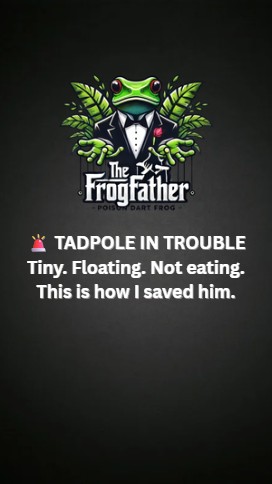Everyone said to cull it. He wasn’t moving. Barely grew. Curled tail. No feeding response. But something in me said, “Not yet.”
This is the story of one weak dart frog tadpole — and exactly how I brought him back from the brink. I’ll walk you through signs of failure, the rescue setup, feeding tricks, and when it’s right to intervene.
Spotting a Struggling Tadpole
Weak tadpoles show a few key red flags:
- Floating at the surface, belly-up
- Curled or crooked tail
- Size far behind siblings
- No feeding response
- Pale, underdeveloped gills
Many keepers euthanise at this stage. But not all of them are doomed — especially if you intervene early.
The Likely Causes
In my case, the culprit was a combo:
- Slight ammonia in group cup (0.25ppm)
- Not enough aeration
- Too much food fouling water
- Competition from stronger siblings
Once I tested the water and removed him, recovery began.
The Rescue Setup
I moved him to a 300ml deli cup with:
- 150ml aged RO water + trace minerals
- 1 Indian almond leaf (for tannins + antifungal properties)
- Temp maintained at 25.5°C with a heat mat and stat
- Shaded spot, no direct lighting
The water was static — no air stone. Tadpoles this weak can’t handle current. I changed 25% daily with pipette.
Feeding the Unfeedable
Live food didn’t work. Microworms just wriggled past him. Repashy Igapo powder? That was the game changer.
I used:
- A grain-of-rice-sized smear on a clean toothpick
- Mixed into water like a micro soup cloud
- Swirled near his mouth twice a day
First few days — nothing. But I kept the routine.
Week-by-Week Recovery Timeline
- Week 1: Floating. Slight gill movement. Still alive.
- Week 2: Curled tail straightened. Swam weakly.
- Week 3: Fed visibly. Eyes sharper.
- Week 4: Grew 30%. Colour darkened. Now alert.
- Week 5: Moved to 500ml grow-out tub. Joined a sibling.
He made it to froglet stage — slightly smaller, but bold and feeding.
When to Try — and When Not To
Good candidates for rescue:
- Still swimming
- Responds to light or vibration
- Clear eyes and defined mouth parts
Probably too late if:
- No movement for 24 hrs
- White spots or fungus visible
- Sinking stiff or bent
Building a Micro Tadpole ICU (on the cheap)
- 300ml deli cups with lids
- RO water or spring (dechlorinated)
- Indian almond leaf (or rooibos teabag)
- Heat mat + digital thermostat
- Pipette for water changes
- Repashy Igapo or fine powdered algae food
Optional but useful:
- Magnifying glass
- Tiny LED torch
- Soft artist paintbrush (for nudging food)
FAQ: UK Tadpole Rescue Questions
Can I use tap water for sick tadpoles?
Avoid it unless heavily dechlorinated and chloramine-free. RO or bottled spring water is safest.
Is microworms or Repashy better for weak tadpoles?
Repashy. Less movement stress, easier to absorb, lower fouling risk.
How many tadpoles can I keep together safely?
Max 4 per 500ml in early stages. More = ammonia spikes and bullying.
Do almond leaves actually help?
Yes. They release tannins that reduce bacterial/fungal growth and create natural blackwater.
When should I cull?
Only when clearly suffering or necrotic. But don’t be too quick — some late bloomers thrive.
Final Takeaway
Rescuing tadpoles is effort. But it’s one of the most rewarding things a frogkeeper can do. Not every one will make it — but if you’ve got time, the right tools, and a little patience, you might just be surprised.



